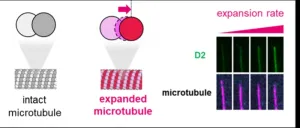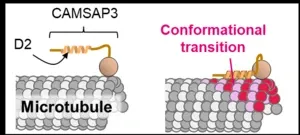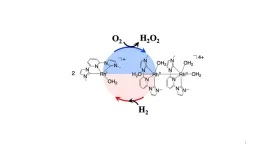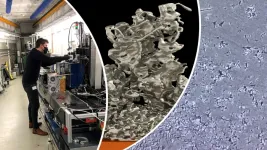(Press-News.org) Like poles support a tent, microtubules—hollow cylindrical structures made of tubulin protein—support eukaryotic cells. But microtubules provide more than just mechanical strength; they help prepare the cell for cell division and migration and work as a railway track on which motor proteins transport materials within the cell. The formation of microtubules within cells resembles how a child assembles a Lego train track. The tubulins—Lego bricks—constantly assemble and disassemble to make the microtubule—train track—longer and shorter in processes called polymerization and depolymerization. The processes are regulated by microtubule-associated proteins such as CAMSAP3 that can stabilize the microtubules. A new study by Hanjin Liu and Tomohiro Shima of the University of Tokyo clarifies how CAMSAP3 stabilizes microtubules. The findings further our understanding of various cellular processes involving microtubules.
"Maintaining the proper length and distribution of microtubules in the cell is critical for survival. So, microtubule-binding proteins control the microtubule dynamics,” says Shima. “CAMSAP3 is a recently found microtubule-binding protein. It specifically binds to one of the two tips of each microtubule and stabilizes the tip to prevent it from depolymerizing.”
How exactly does it stabilize the microtubule tips? To answer that, the researchers considered the structures of CAMSAPs and the microtubules. Unlike rigid Lego bricks, the tubulins in a microtubule show flexibility in their alignment. Some stabilized microtubules are known to have an expanded structure in which the distance between tubulins is greater than that of normal microtubules. And within CAMSAP3, a region called D2 contributes to microtubule stabilization. The researchers conducted an array of experiments to show that the D2 region preferentially attaches to expanded microtubules. Adding an excessive amount of D2 expanded the microtubule structure and slowed microtubule depolymerization by 18-fold. Voila! A possible mechanism for how CAMSAP3 protein stabilizes microtubules: the D2-induced expansion of the microtubule structure inhibits depolymerization.
“CAMSAP3 plays a role in various cellular phenomena, such as cell-cell binding and the development of neurons and cancer cells, through its microtubule-stabilizing ability,” says Shima. “Given the multifunctionality of microtubules, our findings provide a key concept to understanding how various cellular phenomena are controlled by tuning microtubule dynamics.”
“Also, an abnormal CAMSAP3 can cause diseases like kidney disease and malignant cancer,” explains Shima. “Although this study only examined the activity of the protein at the molecular level, it may contribute to better understanding the diseases and their treatment methods in the future.”
The researchers also hope to reveal how D2 discriminates between expanded and compact microtubules at the atomic level, which may allow them to engineer a protein with an even greater ability to discriminate between them. Such an engineered protein can be used as an anti-cancer drug to stabilize microtubules and stop cell division.
###
Related links
The School of Science, UTokyo: https://www.s.u-tokyo.ac.jp/en/
END
Like a flexible Lego railway track: How stable microtubules form within cells
Scientists found the molecular basis of how CAMSAP3 protein stabilizes microtubules within eukaryotic cells, furthering our understanding of various cellular processes
2023-03-09
ELSE PRESS RELEASES FROM THIS DATE:
What if California didn’t close down during the pandemic?
2023-03-09
SAN FRANCISCO (March 9, 2023) — Researchers at the California Academy of Sciences, along with a collaborator at Denison University, have developed an innovative new model to assess how the California economy might have fared without economic closures to slow the spread of the coronavirus pandemic. Their initial findings—published today in Frontiers in Physics—reveal that under a “business-as-usual” approach wherein there were no business closures, California’s economy would have generally been better off than in reality. However, the economic impacts would still have been substantial and ...
Americans share fake news to fit in with social circles
2023-03-09
Both conservative and liberal Americans share fake news because they don’t want to be ostracized from their social circles, according to research published by the American Psychological Association.
“Conformity and social pressure are key motivators of the spread of fake news,” said lead researcher Matthew Asher Lawson, PhD, an assistant professor of decision sciences at INSEAD, a business school in France. “If someone in your online tribe is sharing fake news, then you feel pressure to share it as well, even if you don’t ...
A safe synthesis of hydrogen peroxide inspired by nature
2023-03-09
Fukuoka, Japan—Hydrogen peroxide is a ubiquitous chemical found in most homes and used in everything from dying hair to treating wounds. It is also an invaluable agent for many industries from food, textiles, and even in semiconductor production.
Reporting in JACS, researchers at Kyushu University have developed a new process to synthesize this chemical utilizing a new homogeneous catalyst inspired by nature. Moreover, the process is significantly safer than conventional methods.
Scientists have been reporting the synthesis ...
A novel mechanism may be effective in patients with severe hypertriglyceridemia and prior episodes of acute pancreatitis
2023-03-09
A novel type of therapy, known as ANGPTL3 inhibitor therapy, was effective in lowering triglycerides in certain types of patients with severe hypertriglyceridemia (sHTG) who had a prior episode(s) of acute pancreatitis. sHTG is a well-established risk factor for recurrent episodes of acute pancreatitis. These high-risk patients were the focus of a phase 2 study that was led by the Icahn School of Medicine at Mount Sinai and sponsored and funded by Regeneron.
This ANGPTL3 inhibitor therapy, the intravenous drug evicanumab-dgnb, inhibits two important regulators of lipoprotein metabolism. ...
Researchers unveil smart contact lens, capable of implementing AR-based navigation
2023-03-09
With the advent of the Metaverse era, there have been growing expectations that virtual reality (VR) and augmented reality (AR) technologies will likely to enhance convenience in everyday life, as well as industry productivity performance.
A joint research team, affiliated with UNIST has introduced core technology for smart contact lenses that can implement AR-based navigation through a 3D printing process. According to the research team, the new smart contact lenses can be worn inside the eye of a person, like a normal contact lens.
Published in the February 2023 issue of Advanced Science, this breakthrough has been jointly led by ...
3D battery imaging reveals the secret real-time life of lithium metal cells
2023-03-09
Innovative battery researchers have cracked the code to creating real-time 3D images of the promising but temperamental lithium metal battery as it cycles. A team from Chalmers University of Technology, Sweden, have succeeded in observing how the lithium metal in the cell behaves as it charges and discharges.
The new method may contribute to batteries with higher capacity and increased safety in our future cars and devices.
“We’ve opened a new window in order to understand – and in the long term to optimise – the lithium metal batteries of the future. When we can study exactly what happens to the lithium in ...
Naturally occurring peptide may tackle the ‘root cause’ of obesity-related conditions
2023-03-09
Research published today shows that a peptide (small protein) called PEPITEM could provide a revolutionary approach to reducing the risk of type 2 diabetes and other obesity-related diseases such as hepatic steatosis (fatty liver).
The researchers used an animal model of obesity to investigate whether PEPITEM, delivered by a slow-release pump, could prevent or reverse the effects that a high fat diet has on the pancreas. Excitingly, the results showed that administration of PEPITEM significantly reduced the enlargement of insulin-producing cells in the pancreas and ...
C-reactive protein reduces the immune response in inflammatory disease
2023-03-09
The biological function of the C-reactive protein, CRP, has long been unknown. Researchers at Linköping University in Sweden now show that this protein has a beneficial function in systemic lupus erythematosus, SLE, an inflammatory disease. But this is true only for one of CRP’s two forms, according to the study published in Journal of Autoimmunity.
Most of us have had a CRP blood test on more than one occasion. This is a very common routine health care test used to detect infection or systemic inflammation in the body. What is measured is the level of C-reactive protein, or CRP for short.
“CRP ...
Study: Higher fracture risk after total hip replacement when cementless implant used to treat femoral neck fracture
2023-03-09
A study by Hospital for Special Surgery (HSS) and other centers found that total hip replacement performed with a cementless prosthesis for a femoral neck fracture led to a higher rate of a second fracture and subsequent revision surgery. The research was presented today at the American Academy of Orthopaedic Surgeons (AAOS) Annual Meeting in Las Vegas. The results were also published online in The Journal of Arthroplasty in October 2022.
Treatments for a femoral neck fracture range from nonoperative management to total hip replacement. When hip replacement is the best treatment option, it can be performed with or without bone cement to secure the prosthesis.
“Femoral ...
Mass General researchers discover the role of intestinal fibrosis in inflammatory bowel disease
2023-03-09
Intestinal fibrosis is a common feature of inflammatory bowel disease (IBD) and the primary cause of end-stage organ failure. Traditionally considered a bystander of inflammation, with negligible involvement in disease pathogenesis, new research published in Gastroenterology now shows that fibrosis has a direct bearing on disease progression in IBD.
The investigation was spearheaded by Nima Saeidi, PhD, Associate Professor of Surgery at the Massachusetts General Hospital (MGH) and Harvard Medical School, along with co-first authors, Shijie He, PhD, and Peng Lei, PhD.
The critical question posed by the investigators ...
LAST 30 PRESS RELEASES:
Numbers in our sights affect how we perceive space
SIMJ announces global collaborative book project in commemoration of its 75th anniversary
Air pollution exposure and birth weight
Obstructive sleep apnea risk and mental health conditions among older adults
How talking slows eye movements behind the wheel
The Ceramic Society of Japan’s Oxoate Ceramics Research Association launches new international book project
Heart-brain connection: international study reveals the role of the vagus nerve in keeping the heart young
Researchers identify Rb1 as a predictive biomarker for a new therapeutic strategy in some breast cancers
Survey reveals ethical gaps slowing AI adoption in pediatric surgery
Stimulant ADHD medications work differently than thought
AI overestimates how smart people are, according to HSE economists
HSE researchers create genome-wide map of quadruplexes
Scientists boost cell "powerhouses" to burn more calories
Automatic label checking: The missing step in making reliable medical AI
Low daily alcohol intake linked to 50% heightened mouth cancer risk in India
American Meteorological Society announces Rick Spinrad as 2026 President-Elect
Biomass-based carbon capture spotlighted in newly released global climate webinar recording
Illuminating invisible nano pollutants: advanced bioimaging tracks the full journey of emerging nanoscale contaminants in living systems
How does age affect recovery from spinal cord injury?
Novel AI tool offers prognosis for patients with head and neck cancer
Fathers’ microplastic exposure tied to their children’s metabolic problems
Research validates laboratory model for studying high-grade serous ovarian cancer
SIR 2026 delivers transformative breakthroughs in minimally invasive medicine to improve patient care
Stem Cell Reports most downloaded papers of 2025 highlight the breadth and impact of stem cell research
Oxford-led study estimates NHS spends around 3% of its primary and secondary care budget on the health impacts of heat and cold in England
A researcher’s long quest leads to a smart composite breakthrough
Urban wild bees act as “microbial sensors” of city health.
New study finds where you live affects recovery after a hip fracture
Forecasting the impact of fully automated vehicle adoption on US road traffic injuries
Alcohol-related hospitalizations from 2016 to 2022
[Press-News.org] Like a flexible Lego railway track: How stable microtubules form within cellsScientists found the molecular basis of how CAMSAP3 protein stabilizes microtubules within eukaryotic cells, furthering our understanding of various cellular processes








